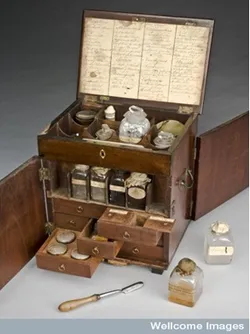Therapy in the Private Asylum
Jane Hand
But of all Medicines in the Spleen, I know none equal or fit to compare with that truly noble Drug we call Opium. It’s our Refuge in all Distresses; it gives Ease and Relief in the most torturing of Pains, and when all other remedies fail;... for by relaxing the Fibres of the Brain and Nerves... totally destroy their Sensations, or at least greatly impairs them; whereupon it comes to pass, that the Perceptions are intercepted for a while, and a pleasing Stupefaction brought upon all the Organs, that serve the several Senses, which Phaenomenon we call Sleep. (Nicholas Robinson, A New System of the Spleen, Vapours and Hypochondriack Melancholy (London: printed for A. Bettesworth, W. Innys, and C. Rivington, 1729), pp.201-209.)
The restoration of the lunatic to health was a declared objective of many eighteenth-century private madhouses. Despite their reputation as places of containment and, oftentimes, wrongful confinement, madhouses employed numerous approaches to treatment and cure. The majority of medical treatments during this period remained centred on humoral theory, which sought to restore bodily balance. Many therapies focused on various forms of ‘physic’, especially emetics and purgatives. In addition, more physical or ‘heroic’ forms of treatment would be employed such as bleeding, blistering and cold bath therapy. In addition, shaking and spinning the body as a therapy for madness, were also utilised earlier in the century.

Medicine chest containing treatments for vomits (emetics) and sweating (diaphoretics) as well as general purgatives such as rhubarb, jalap and calomel, c. 1801.
In addition, the use of opium and opiates was widespread, employed to calm patients and help them sleep; it is likely that these were also used to dope and manage refractory patients. Madhouse proprietors also used techniques to control and change patient behaviour. The employment of instruments of physical coercion and mechanical restraints has given rise to negative images of asylum care with therapy having a low priority. Certainly, chains, leg-locks, straitjackets, restraint chairs, bed straps and other devices were in widespread use. There was little consensus about what constituted effective treatment and consequently a variety of therapies were administered throughout this period.
The treatments developed at this time combined medical approaches with various methods for managing patients and controlling their behaviour. The ability to ‘cure’ was increasingly becoming the measure for a successful private lunatic asylum. The insanity of King George III did much to raise the profile of private asylum care, as Dr Francis Willis, who ran such an institution in Lincolnshire, was called upon to treat (and apparently cure) the King. During this period, it was widely claimed that a well-designed and well-managed asylum would in itself greatly assist in the restoration of mental health to the insane. The attempt to create a supportive and calm environment within the private asylum was an early manifestation of the use of the ‘milieu’ as a therapeutic tool.
Even prior to the widespread application of ‘moral treatment’ as a therapeutic system at the York Retreat in 1790s, numerous private madhouses utilised treatments based on kindness and consideration rather than a reliance on physical restraint. Dr William Battie, a physician to St Luke’s Hospital for Lunatics in London, contended that ‘management does more than medicine’, an idea that gained legitimacy by the end of the century. By then non-medical aspects of treatment, ‘psychological’ approaches aimed to restore self-management in the patient, had been adopted by a significant number of specialist mad-doctors.
Further Reading:
• Allan Ingram, Patterns of Madness in the Eighteenth Century: A Reader (Liverpool: Liverpool University Press, 1998).
• William Ll. Parry-Jones, The Trade in Lunacy: A Study of Private Madhouses in England in the Eighteenth and Nineteenth Centuries (London: Routledge & Kegan Paul, 1972).
• Leonard Smith, ‘A Gentleman’s Mad-doctor in Georgian England: Edward Long Fox and Brislington House’, History of Psychiatry, 19:163 (2008), pp.163-184.
• Leonard Smith, ‘Eighteenth-century Madhouse Practice: The Prouds of Bilston’, History of Psychiatry, 3:45 (1992), pp.45-52.
